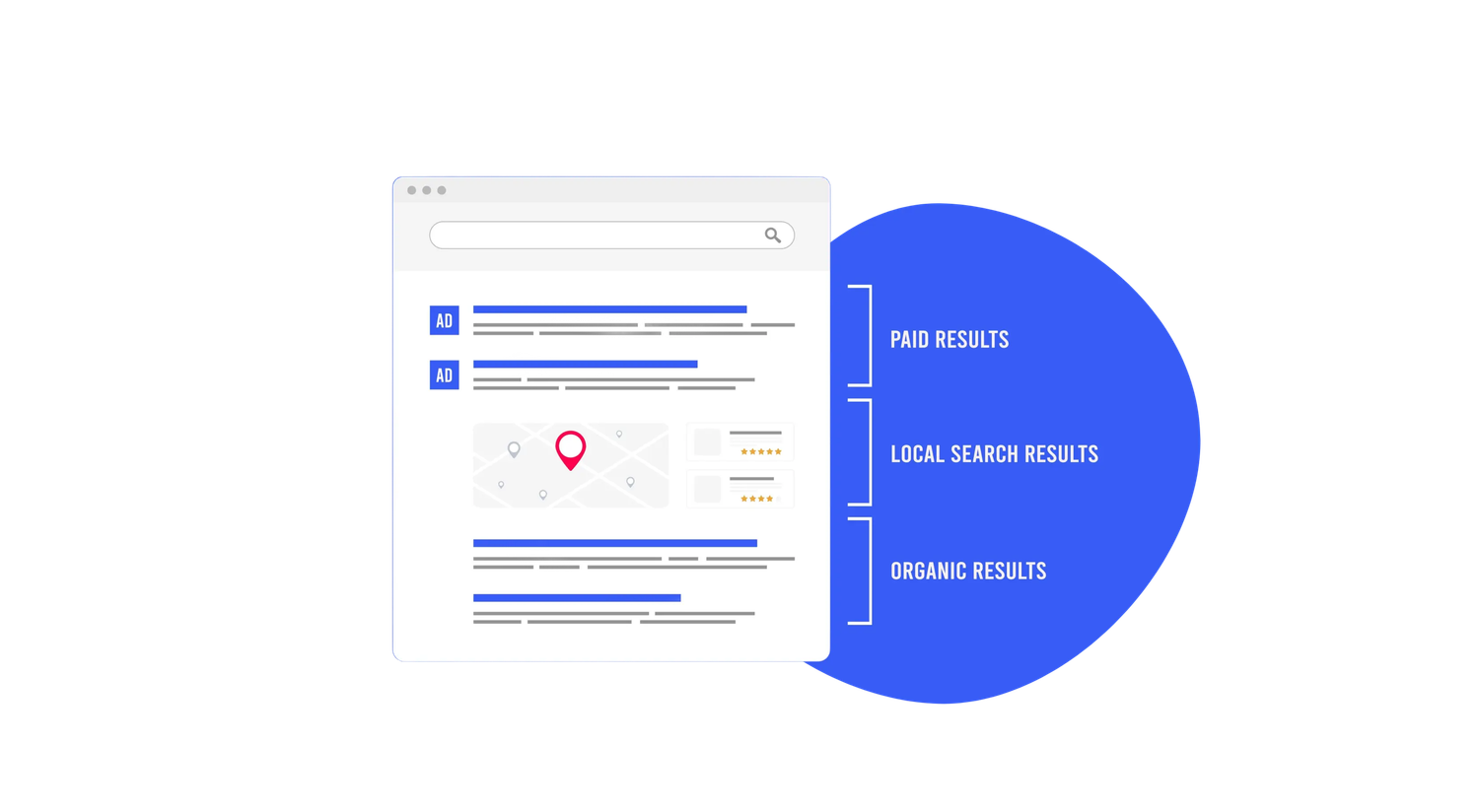What is local SEO and why does it matter?
Local SEO (Search Engine Optimisation) is the process of optimising online presence to increase ranking, local search visibility, and brand awareness for local search results on Google and other search engines.
It matters because it helps your business show up at the exact moment nearby customers are actively searching for your products or services — and actually ready to convert.
Why is content important for local SEO?
There are many reasons why content is vital for local SEO. While content is crucial for all kinds of businesses, it can also help small to medium enterprises (SMEs) compete with the big dogs – when executed correctly.
Avoid getting lost amongst the competition – content can help local customers find your business. Knowing what kind of compelling content to create and how to execute it makes a massive difference in amplifying your small business’s voice online.
1. Provides relevant results
Accurate content helps fulfil search intent by reaching audiences across all stages of the buyer’s journey.
The five types of search intent are:
- Informational: What is this? Example: What is a calming dog bed?
- Navigational: Take me to this website. Example: Petbarn login
- Commercial investigation: (compare products and services): Which is better, X or Y? Example: What’s the difference between a regular and calming dog bed?
- Local queries: (geographically): Where can I find them? Example: calming dog bed Sydney CBD
- Transactional: Take my money. Example: buy a dog bed online in Australia

2. Helps website indexing
Website indexing is the process of registering a webpage’s content to be considered for rankings. It’s almost like applying for an award – where the award is the number one search result on Google.
3. Provides a clear call-to-action (CTA)
A clear and compelling CTA is instrumental for local SEO.
Well-optimised CTAs can:
- Improve user experience (UX): faster page load times help increase conversions. The sweet spot is anything under 2 seconds for optimal results.
- Drive click-through rates (CTR): despite the CTR crisis, we discovered that lower-ranking positions (6-10) on desktops are increasing. This is crucial for underdog websites (like your SME) to climb the Google ranks.
- Maximise conversions: CTAs guide users along the buyer’s journey, helping convert them from visitors to customers.
Understanding the marketing funnel
Understanding the customer journey and marketing funnel can help source local SEO opportunities.
By producing content tailored for a specific local audience, you can guide them further down the funnel and increase your chances of conversion.
Let’s identify some examples of content types according to where they sit in the marketing funnel.
Top of the funnel
Awareness: thought leadership pieces, infographics, intro blog posts.
Middle of the funnel
Consideration: FAQs, whitepapers, templates, interviews, and comparisons.
Bottom of the funnel
Conversion: products, service pages, case studies, testimonials.

9 content marketing strategies for local SEO
Content spans all corners of your local SEO strategy. So, what kind of content should you create to attract local customers? Let’s dive into our top local SEO tips.
1. Perform strategic local keyword research
Before you even start writing, get specific. Research location-based keywords that combine services and suburbs, like:
- “emergency plumber South Yarra”
- “wedding venues Mornington Peninsula”
- “best Italian restaurant Marrickville”
Tips:
- Use keyword research tools (like Semrush, Ahrefs or Google Keyword Planner) to uncover long-tail local variations with lower competition.
- Decipher whether a keyword has local intent by checking the Google Search results for maps and local business listings.
- Add geo-modifiers to broader service terms - think “car detailing” vs. “car detailing Newcastle”.
- Check the “People also ask” and “Related searches” sections in Google for extra inspiration.
2. Optimise your Google Business Profile (formerly Google My Business)
Considering Google’s ever-increasing focus on search intent, it’s unsurprising that Google Business Profiles (GBPs) have become a highly effective starting point for putting your company on the map. Not only is it free to use, but research shows that almost half of local businesses receive over a thousand views on their GBP listing.
Make sure to update your details if they change to maintain relevance, like opening hours, address and phone number.
3. Publish video content
Featuring local elements in your video content not only with your audience but with Google, too. By aligning video content with local search intent, you can attract a more targeted audience and improve your local SEO efforts.
Plus, video content is exceptionally versatile and could even help you reach a wider audience.
Top Tip:
Edit footage into shorter clips so it can be:
- Embedded on your website
- Shared across social media
- Featured in blog posts
- Uploaded to your Google Business Profile
Don’t forget to highlight your relevant keywords in the video title and description to help climb the SERP ranks.

4. Structure data with schema markup
Schema markup is a type of structured data. Think of it as the good bacteria of your website’s gut. It's not visible to the human eye but is effective in promoting healthy interactions. Embedded into your site’s code, schema markup informs indexing bots what your content is about.
Here are some recommended schemas for local SEO:
- Geolocation
- Opening hours
- Price range
- FAQs
- Blog
- Contact us
- About us
- Reviews
- Speakable schema for voice search
5. Encourage customers to post reviews
Spread the word that you’re the best in the business by encouraging customers to leave a review. Positive reviews aren’t just an ego boost; they also help improve your local ranking.
Benefits of online reviews:
- Strength in numbers: The more (positive) reviews, the better, as they provide Google with more content to crawl. Encourage existing customers to leave a review and try to make the process as fast and easy as possible. For example, email recent customers with a direct link to your GBP review section.
- Count your lucky stars: A 4.5 rating is the sweet spot as 5-star ratings might be construed as fake news. Aim to maintain a rating above four stars, as Google will filter out anything lower and not appear in the “best dog groomers near me” results.
- Avoid old news: Customers and Google appreciate recent reviews. An active profile reassures audiences that your business is healthy and thriving.
Top Tips:
- Case studies and video testimonials strengthen your service and product pages by showcasing USPs, demonstrating your expertise, and proving how you outperform the competition - all with credible, high-quality content that builds trust.
- Respond to reviews so Google understands that you endeavour to engage with your customers to provide exceptional customer service.

6. Optimise meta data and headings
Your page’s meta data and H1 are the first things Google (and users) see. Make them count.
Meta title tips:
- Include your target keyword and location at the beginning.
- Include your brand name at the end.
- Keep it under 60 characters including spaces.
- Use dashes instead of pipes.
- E.g. “Affordable Dog Grooming in Brunswick - Paws & Co.”
Meta description tips:
- Summarise your local offering in 2-3 short sentences.
- Target your local keyword in the first sentence.
- Maximise real estate by incorporating secondary keywords.
- End with a concise and compelling CTA.
- Keep it under 155 characters including spaces.
- E.g. “Looking for dog grooming in Brunswick? Visit Paws & Co. for expert services including nail-clipping, de-matting, teeth cleaning and more. Book online now!”
Header structure tips:
- Target your primary keyword in the H1, e.g. “Dog Grooming in Brunswick”
- Use H2s to break down services, reviews, FAQs, or benefits.
- Don’t overstuff with keywords; instead, keep headers helpful and user-focused.
7. Build dedicated service and location pages
Don’t try to cram every suburb into one “catch-all” page as this weakens your SEO and creates a confusing user experience. Instead, build a dedicated page for each key location or service area.
Structure tips for each location page:
- Intro paragraph: Outline who you are, what you do, and why this location matters.
- Local services: List and explain offerings specific to the area.
- Trust signals: Add location-specific testimonials or case studies.
- Unique CTAs: Include clear actions relevant to the suburb, like “Book now in Paddington” or “Speak to our Adelaide team”.
- Maps and images: Include local visuals (not stock!) and an embedded Google Map if you have a physical location.
- FAQs: Address common customer questions tailored to the area.
This page setup shows Google you’re a real player in the local space, not just another generic brand trying to rank in every postcode.
8. Optimise for voice search
Hey Google, where’s the best puppy school around here?
Vocalised internet searches differ in many ways compared to search bar queries. People use longer sentences and more colloquial phrases. We reckon this presents more opportunities for your local SEO.
According to the folks at BrightLocal, 75% of people who own smart speakers use integrated voice assistants to search for local businesses every week.
Crank up the volume on your local content with the following tips:
- Target long-tail keywords and geo modifiers to match specific user intent.
- Optimise for Featured Snippets and People Also Ask sections by succinctly answering question keywords.
- Use conversational language while remaining authoritative.
- Maintain an up-to-date Google Business Profile because most voice search results are pulled from GBPs.
9. Adhere to a mobile first strategy
Local searches are predominantly performed on mobile, meaning you should ensure that your site is optimised accordingly.
Picture this. You’re famished after an intense fetch session with your golden retriever at the local dog park and need sustenance. Not all cafes love your furry friend as much as you do. When you search for a “dog-friendly café near me open now”, you want to be able to choose from a list of results that cater to you and your pooch’s needs.
Make it easier for customers to find you from an impromptu search by ensuring your site is optimised for mobile. When considering rankings, Google rewards websites for responsive designs, so it’s worth considering how to make your site more user-friendly.
The better your website’s performance, the more you’ll appear in search results for local queries like “near me”.
Here are some ways to improve UX for mobile search:
- Faster load times
- Concise content
- Mobile schemas
Can you duplicate content with local SEO?
Spoiler alert: duplicating content is a bad move.
Yes, it’s tempting to spin the same landing page for every suburb by swapping out the location name. But Google’s not buying it - and neither are your potential customers. Duplicate content can confuse search engines, dilute your rankings, and miss the opportunity to speak directly to your target audience.
Instead, invest in creating unique, localised content that reflects what’s actually happening in that area.
Here’s what to do instead:
- Highlight local proof points: Mention suburbs, landmarks, customer stories or service areas relevant to that location.
- Include local schema markup: Help search engines understand the context of your content.
- Customise your CTAs: “Book a plumber in Carlton today” is more powerful than “Contact us.”
Remember, your goal isn’t just ranking, it’s resonating. Great content marketing for local SEO makes your audience feel like you understand their area and their needs.
FAQs
How does local SEO work?
Local SEO works by helping your business appear in local search rankings when users look for nearby services, think “dentist near me” or “café in Surry Hills.”
It aligns your website content with local search intent and ranking factors to help you appear in search engine results pages (SERPs) and online directories.
By creating geo-targeted content, Google can connect you with local searchers in your area. The goal? Get your site in front of the right people at the right time, right when they’re ready to act.
Why is local SEO important for small businesses?
If you’re a local business owner, visibility matters - and local SEO puts you on the map. Literally.
Here’s why it matters:
- Local search rankings are often the first results users see.
- Most people searching for local service providers are ready to buy or book.
- It helps your business stand out in crowded local listings like Google Maps, Apple Maps, and Yelp.
- It boosts credibility thanks to consistent positive reviews.
If you’re not showing up in search, your competitors probably are.
How long does local SEO take to work?
Local SEO isn�’t an overnight fix, but it does build long-term results. On average, you’ll start seeing meaningful movement in your local SEO rankings within 3 to 6 months, depending on competition and how well-optimised your site is.
Here’s what can influence the timeline:
- Accuracy and consistency of your online listings
- Quality of your backlinks from other websites
- Number of existing local citations and reviews
- Whether you’ve claimed and optimised your business directories
- Your content’s relevance to specific local sites and audiences
Want to speed things up? Prioritise your Google Business Profile, build local backlinks, and create location-specific content that speaks directly to your audience.
Conclusion
Looking for local SEO advice near me?
Whether you need help crafting location-specific content or optimising your site for better visibility, we’ve got you covered. Our team of SEO specialists can help you climb the local search rankings and connect with the customers that matter.
Book a chat with Lewis, our Head of Organic Media & Content. Let’s put your business on the map.
Written by
Brίd Flynn




